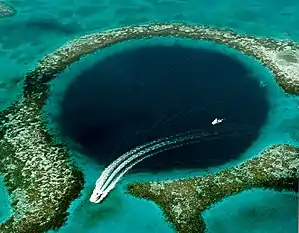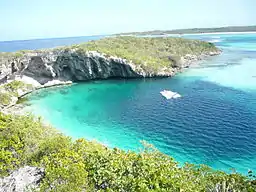Blue hole
A blue hole is a large marine cavern or sinkhole, which is open to the surface and has developed in a bank or island composed of a carbonate bedrock (limestone or coral reef). Their existence was first discovered in the late 20th century by fishermen and recreational divers.[1] Blue holes typically contain tidally influenced water of fresh, marine, or mixed chemistry. They extend below sea level for most of their depth and may provide access to submerged cave passages.[2] Well-known examples are the Dragon Hole (in the South China Sea) and, in the Caribbean, the Great Blue Hole and Dean's Blue Hole.



Blue holes are distinguished from cenotes in that the latter are inland voids usually containing fresh groundwater rather than seawater.
Description
Blue holes are roughly circular, steep-walled depressions, and so named for the dramatic contrast between the dark blue, deep waters of their depths and the lighter blue of the shallows around them. Their water circulation is poor, and they are commonly anoxic below a certain depth; this environment is unfavorable for most sea life, but nonetheless can support large numbers of bacteria.[3] The deep blue color is caused by the high transparency of water and bright white carbonate sand. Blue light is the most enduring part of the spectrum; other parts of the spectrum—red, yellow, and finally green—are absorbed during their path through water, but blue light manages to reach the white sand and return upon reflection.
The deepest blue hole in the world at 300.89 meters (987 feet) deep is in the South China Sea and is named the Dragon Hole, or Longdong.[4] The second deepest blue hole in the world with underwater entrance at 202 metres (663 ft) is Dean's Blue Hole, located in a bay west of Clarence Town on Long Island, Bahamas. Other blue holes are about half that depth at around 100–120 metres (330–390 ft). The diameter of the top entrance ranges typically from 25–35 metres (82–115 ft) (Dean's Blue Hole) to 300 metres (980 ft) (Great Blue Hole in Belize).
The overall largest blue hole (taking into account depth and width) is located 100 kilometers from the coast of Belize. The Great Blue Hole is a massive 300 meters wide and 125 meters deep.[5]
Formation
Blue holes formed during past ice ages, when the sea level was as low as 100–120 metres (330–390 ft) lower than at present.[6] At those times, these formations were targets of the same erosion from rain and chemical weathering common in all limestone-rich terrains; this ended once they were submerged at the end of the ice age.
Most blue holes contain freshwater and saltwater. The halocline is the point in these blue holes where the freshwater meets the saltwater and where a corrosive reaction takes place that eats away at the rock.[7] Over time this can create side passages, or horizontal "arms", that extend from the vertical cave. These side passages can be quite long; e.g., over 600 metres (2,000 ft) in the case of the Sawmill Sink in the Bahamas.
Occurrence
Blue holes are typically found on shallow carbonate platforms, exemplified by the Bahama Banks, as well as on and around the Yucatán Peninsula, such as at the Great Blue Hole at Lighthouse Reef Atoll, Belize.
Many deep spring basins formed by karst processes and located inland also are called blue holes, for example, Blue Hole in Castalia, Ohio.
Life forms
Many different fossils have been discovered that indicate the type of life forms that existed in blue holes. Other life forms such as marine life and marine fossils have also been noticed; crocodile and tortoise fossils,[8] for instance, have been found in blue holes. Important types of bacterial colonies have also been found in blue holes. Due to the conditions of a blue hole, they are forced to live off of sulfur compounds like hydrogen sulfide, which are toxic to most organisms.[6] These special bacteria have produced many insights into the chemistry and biology of microbial life.
Expeditions
Exploring blue holes requires an extremely high level of expertise in the diving field, hence the fact that very few divers have ever attempted it. In 2009, however, a team of scientists set out to study seven of these blue holes in the Bahamas.[9] Through over 150 dives, the scientists, led by Keith Tinker, investigated bacteria able to live in anoxic environments.[9] This allowed them to make connections to fields such as astrobiology where organisms thrive without oxygen or sunlight.
In 2018, another group of scientists set out to explore the Great Blue Hole of Belize using two submarines of the latest technology. One of the major scientific contributions to result from this expedition was the first 3-dimensional map of its interior.[10] The researchers captured features such as stalactites, the hydrogen sulfide layer, and other details that cannot usually be seen by the naked human eye.
As part of a three-year study, a group of scientists set out in May and September 2019 to explore a blue hole nicknamed the "Amberjack Hole" located 30 miles off the coast of Sarasota, Florida. Individuals from Mote Marine Laboratory, Florida Atlantic University, Harbor Branch, Georgia Institute of Technology, the United States Geological Survey, and the NOAA Office of Ocean Exploration participated in the expedition. The expedition gathered information about life around and within the hole, seawater composition, and the hole's bottom sediments. A follow-up expedition is planned in August 2020 to a deeper blue hole named the "Green Banana" off the coast of Florida.[11][12][13]
In contrast to the various successful expeditions completed, many explorers have perished in their attempts to reach the bottom of a blue hole. The Red Sea Blue Hole located in Egypt is nicknamed the "Divers' Cemetery" because at least 40 divers have died there.[14]
References
- Rice, Doyle (July 23, 2020). "Mysterious 'blue hole' near Florida wows scientists". USA Today. Retrieved 24 July 2020.
- Mylroie, J. E., Carew, J. L., and Moore, A. I., (1995), Blue Holes: Definition and Genesis: Carbonates and Evaporites, v. 10, no. 2, p. 225.
- Sajady, Mas (2014). The Real Why. Balboa Prints. ISBN 9781452595993.
- Stephanie Pappas (July 27, 2016). "World's Deepest Blue Hole Is in South China Sea". LiveScience.
- Francesca Street (October 8, 2019). "Dispatches from the bottom of Belize's Blue Hole". Cable News Network.
- Dave Mosher (February 3, 2012). "New Life-Forms Found in Blue Holes—Clues to Life in Alien Oceans?". National Geographic.
- Devotor (July 7, 2019). "8 Most Fascinating Blue Holes in the World". Charismatic Planet.
- Keen, Cathy (December 3, 2007). "Fossils excavated from Bahamian blue hole may give clues of early life". University of Florida. Archived from the original on January 14, 2014. Retrieved April 24, 2016.
- Todhunter, Andrew (August 2010). "Deep Dark Secrets". National Geographic. Retrieved October 29, 2019.
- Francesca Street (October 8, 2019). "Dispatches from the bottom of Belize's Blue Hole". Cable News Network.
- Dockrill, Peter (July 21, 2020). "Researchers Embark to Explore Mysterious 'Blue Hole' Hidden Off The Coast of Florida". Science Alert. Retrieved 23 July 2020.
- "Scientists Embark on Journey to the "Deep" to Explore Blue Holes". Ocean Research and Exploration. Retrieved 23 July 2020.
- Delbert, Caroline (July 22, 2020). "Why Divers Are Venturing Deep Inside a Baffling Blue Hole". Popular Mechanics. Retrieved 23 July 2020.
- Allison Meier (January 8, 2014). "Blue Holes: A Descent into the World's Hidden Waters". Atlas Obscura.
Further reading
- Schwabe, Stephanie; Carew, James L (2006). "Blue Holes: An Inappropriate Moniker for Scientific Discussion of Water-filled Caves in the Bahamas" (PDF). The 12th Symposium on the Geology of the Bahamas and Other Carbonate Regions. Retrieved 1 February 2017.
External links
- World's deepest blue hole found in South China Sea
- PBS TV program "Extreme Cave Diving"
- Bahamas Blue Holes Guide
- Bahamas Introduction
- The Blue Holes Foundation
- Belize Audubon Society
- What's a Blue Hole? Explanation at the Bahamas Caves Research Foundation
